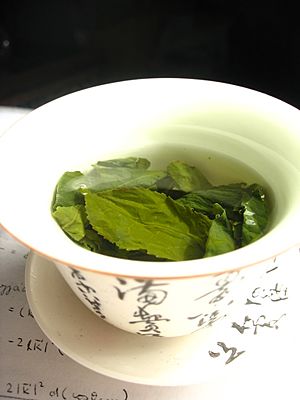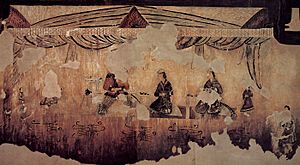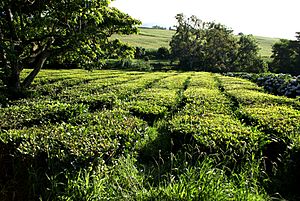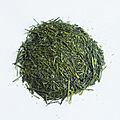Green tea facts for kids

Green tea is a popular drink that comes from a plant called Camellia sinensis. It's special because it goes through very little oxidation (a process like rusting) when it's made. This keeps its fresh green color and taste.
Green tea is very popular in countries like China, Japan, and Korea. Recently, more people in Western countries have started drinking it too, even though black tea is usually more common there.
History of Green Tea

Green tea has a long and interesting history. In Japan, a Buddhist monk named Eisai first brought tea to the country around the 12th century. He learned about it during a visit to China.
- Eisai taught people how to grow tea plants and how to prepare the leaves.
- At first, people drank tea because they thought it was a medicine.
- Over time, drinking tea became a part of Zen Buddhism. It was believed that the caffeine in tea helped keep the mind clear and relaxed during meditation.
- The custom of drinking tea slowly spread across Japan.
The Tea Ceremony
Later, in the Muromachi period, people even had tea-tasting competitions! A Zen Buddhist master named Juko Murata helped change this. He started a simpler tea ceremony, often done in a small space around a tatami mat.
The tea ceremony was made even better by Jou Takeno and Sen no Rikyu in the Azuchimomoyama era. They removed anything extra or unnecessary from the tea room. The main idea was to help people focus on their inner thoughts and feelings, which came from Zen teachings.
In the Edo period, the tea ceremony became popular with many people. It was seen as an artistic skill. The ceremony focused on bringing out the beauty from inside a person's heart.
The main ideas of the tea ceremony are called 和敬清寂 (Wa Kei Sei Jaku). These words mean:
- Wa (harmony): Sharing tea between the host and guest shows harmony.
- Kei (respect): Showing respect by accepting and sharing with others.
- Sei (purity): Treating yourself and others openly and honestly.
- Jaku (tranquility): Feeling a sense of calm and stillness during the ceremony.
Even today, modern tea ceremonies, which can last for hours, are still based on these important ideas.
In the Meiji period, the tea ceremony became less popular for a while. But it was later brought back as part of education for girls. The ceremony also became more focused on being beautiful and elegant.
Today, green tea is enjoyed all over the world. Some people like to add sugar to it because it can taste a bit bitter on its own.
Green Tea and Your Health

Many people believe that green tea has good effects on health.
- It seems to help lower the risk of heart disease.
- The natural substances in green tea may also help protect against some health problems, like certain types of cancer, low bone strength, and kidney stones.
- Green tea contains helpful things like ascorbic acid (Vitamin C) and minerals such as chromium, manganese, selenium, and zinc.
- It is also a strong antioxidant, which means it helps protect your body's cells.
Some studies have looked at how green tea affects cholesterol levels. While animal studies showed it could lower cholesterol, human studies have not always shown the same clear results. However, one study in 2003 found that a green tea extract, with added parts from black tea, did help reduce cholesterol.
Another study showed that people who drank green tea extract burned fat faster during exercise.
A recent study looked at the eating habits of many women. It found that regularly drinking green tea and eating mushrooms was linked to a much lower chance of developing certain health issues.
Images for kids
-
Sencha green tea, the most popular form of tea in Japan.
See also
 In Spanish: Té verde para niños
In Spanish: Té verde para niños










